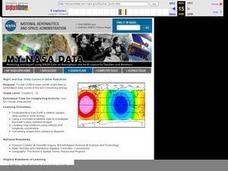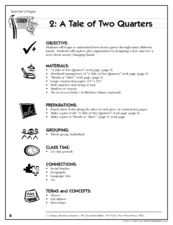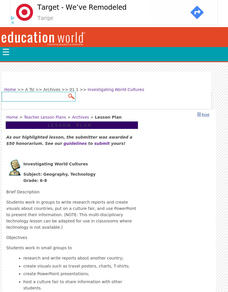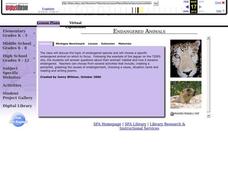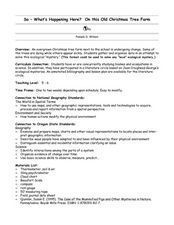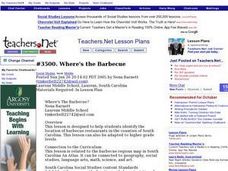Curated OER
NIGHT AND DAY: DAILY CYCLES IN SOLAR RADIATION
Students examine how Earth's rotation causes daily cycles in solar energy using a microset of satellite data to investigate the Earth's daily radiation budget and locating map locations using latitude and longitude coordinates.
Curated OER
A Tale of Two Quarters
Have your class use the life of a quarter to understand and design plot and flow charts. They read the book, The Go-Around Dollar, think about how their teacher got her quarters that day, then create a flow chart. They have to show how...
Curated OER
Investigating World Cultures
Students, in groups, write research reports and create visuals about countries, put on a culture fair, and use PowerPoint to present their information.
Curated OER
Can You See What I See?
Students gain an understanding of the methods used to explore the earth's surface. Students create a time line leading to the first satellite image of the Earth that includes the various methods utilized to observe the earth's surface.
Curated OER
Endangered Animals
Students listen to a teacher led lecture on jaguars, their habitats, and how they became endangered. Using a specified web site, they choose an endangered animal to research. After gathering information, students participate in...
Curated OER
Finding Captain Hook's Treasure
Students use their map-reading skills to find Captain Hook's treasure. They see how the directions on a map correspond with "real-life" directions, and that symbols on a map represent real things.
Curated OER
Cutting Down Trees
Students research what kind of problems force a city or town to decide to remove trees. Students research what controversy has occurred in other cities or towns. Students interview those responsible for such decisions in your city or...
Curated OER
Women
A close study of two works of art provides the introduction to this cross-curricular writing assignment. After comparing the clothing, facial expressions, body language, setting, and color in the two 19th century paintings Tissout’s...
Curated OER
Athens Versus Sparta
Students examine the characteristics of the Greek city-states, Athens and Sparta. They compare and contrast the city-states and compose an essay which includes any similarities and differences of Athens and Sparta.
Curated OER
Chinese New Year
Students complete a variety of activities as they study Chinese New Year and the Chinese Zodiac. They act out a story of the Chinese Zodiac. They make several crafts including Chinese lanterns and paper fortune cookies.
Curated OER
Shake, Rattle and Roll
Students explore how to locate the location of an earthquake and why earthquakes happen more frequently in some areas more than others.
Curated OER
Where Should We Land?
Students discuss the difference between major landforms as a class. In groups, they rate the landforms based on the needs of the community that wish to settle there. They also discuss the push and pull factors of the colonists that made...
Curated OER
Words in the News Dutch EU vote - 01 June 2005
Students complete word work and vocabulary building based on news article about the Dutch EU vote in 2005.
Curated OER
Words in the News Philippine Sedition Charges - 15 June 2005
Students study vocabulary in order to read an online article. They participate in word work before they read and discuss the article. They take an online quiz and a role play activity.
Curated OER
Words in the News Canada Elects New Government - 25 January 2006
Students complete vocabulary and word work before reading an article about Canada. They work with word families by completing worksheets and complete a quiz after reading the article.
Curated OER
Togo's New President
Students read an article about Togo's new President. They locate Togo on a map. They practice using new vocabulary they find in the story. They also complete worksheets.
Curated OER
Words in the News Chile Peru agreement - 29 June 2005
Students develop vocabulary to read and explain an article abou the Chile Peru Agreement. They complete worksheets and on online quiz to increase vocabulary.
Curated OER
SC Populations Along Major Interstates
Students examine the population among the interstates in South Carolina. Using the internet, they identify the counties and roads and compare it with their own drawing.
Curated OER
Extraordinary Explorers
Students, using the Internet, B41460research facts about explorers and travelers. They also state what places they have explored and share with the class.
Curated OER
State Heads
Students create a narrative image that depicts a formal shape of a state. They review the state facts of whatever state they chose. They draw a person and then add text in the shape of the state they chose.
Curated OER
So -- What's Happening Here? On this Old Christmas Tree Farm
Students take a field trip to an old Christmas tree farm near their school. In groups, they gather data at the site and analyze the data in an attempt to discover what happened to the area. They identify human activities that led to the...
Curated OER
Where's the Barbecue?
Students identify the major landforms, regions and rivers on a map of South Carolina. They compare the locations of the major Native American groups in the state as well. They chart where barbecue restaurants are located and write...
Curated OER
GIS and Agriculture
Students are introduced GIS systems and how they operate. Using a GIS system, they locate and map the various types of agricultural products grown in Oregon. They rank each county based on the amount of agricultural products produced and...
Curated OER
Water: On the Surface and in the Ground
Students explore the differences between surface water and ground water. They collect data using maps and graphs and investigate a Texas river basin and a nearby aquifer. They complete a written report including maps and data regarding...


